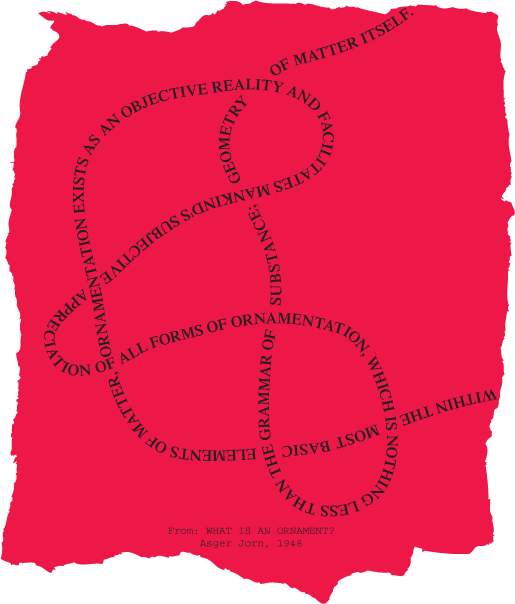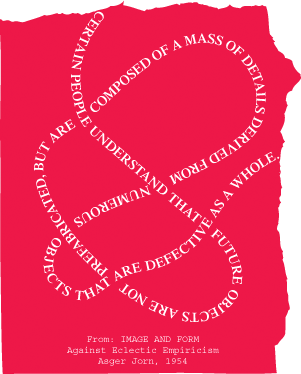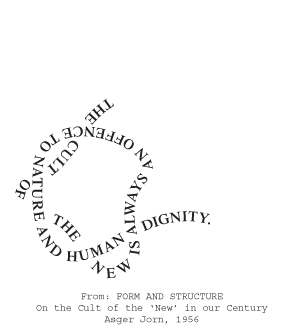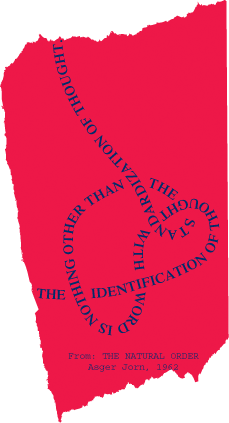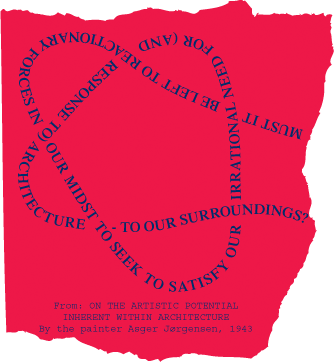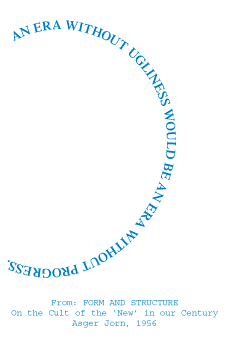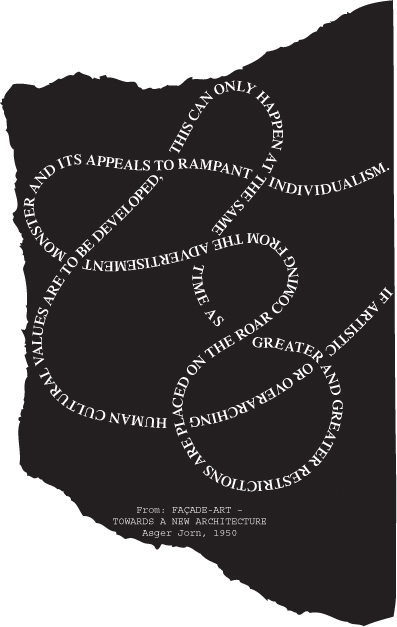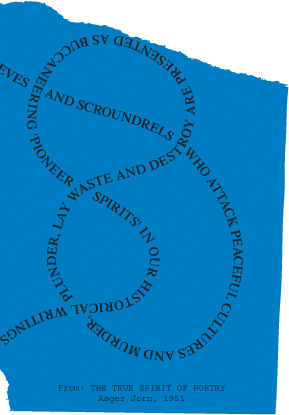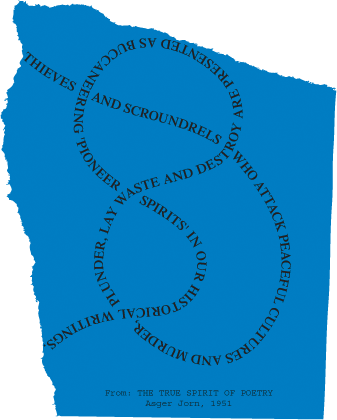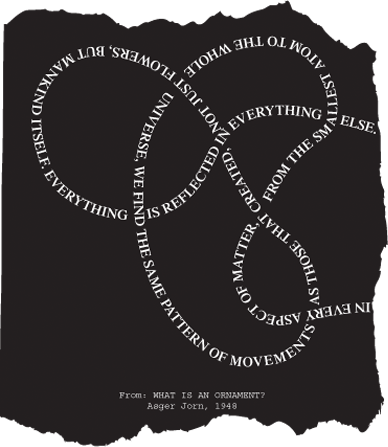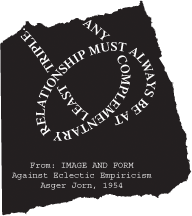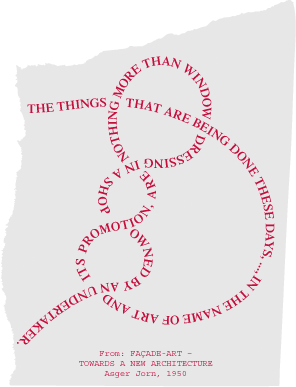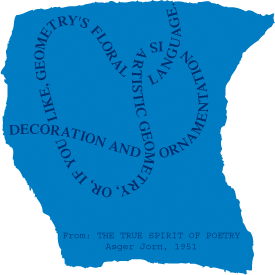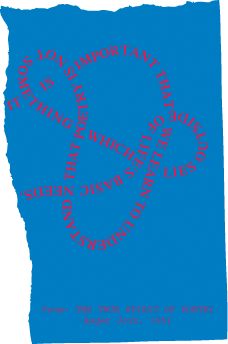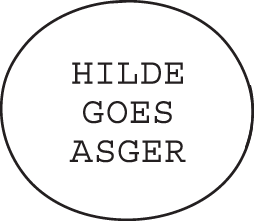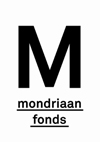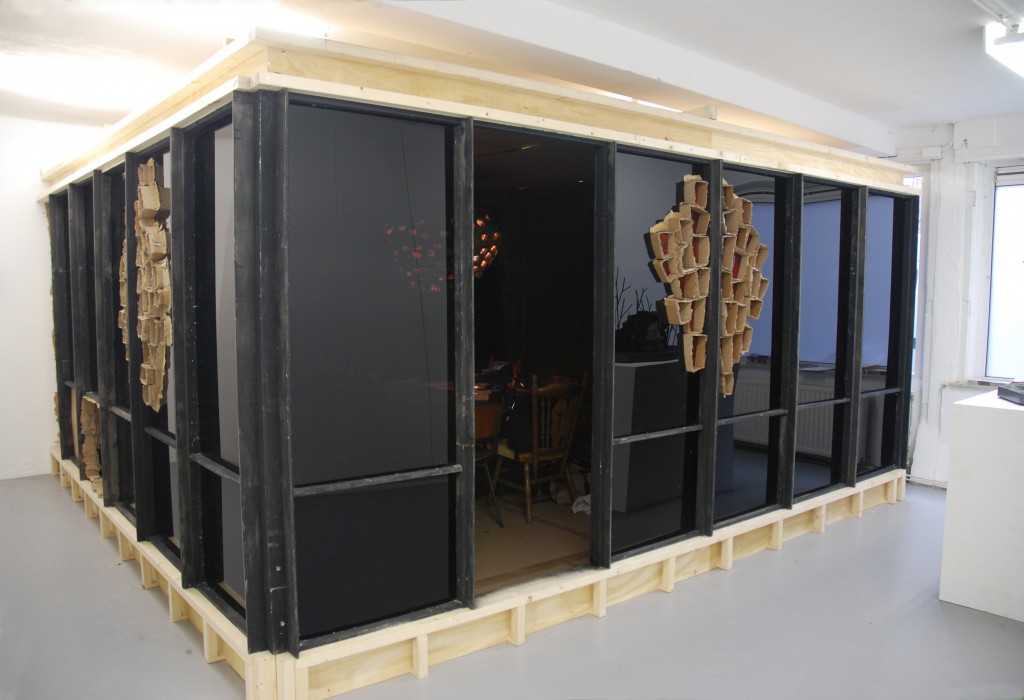L’ARCHITECTURE SAUVAGE – ASGER JORN’S CRITIQUE AND CONCEPT OF ARCHITECTURE
Within the framework of my research into Asger Jorn´s writing and thinking I organize public sessions with special guests at a variety of venues. The guest´s practice, knowledge, insights, or responses are informative to my research, or steer the direction I take on a particular topic. The sessions also often respond to the context of the hosting institution, or to a specific request. Making the sessions public is a way to share and enter into a dialogue with the audiences.
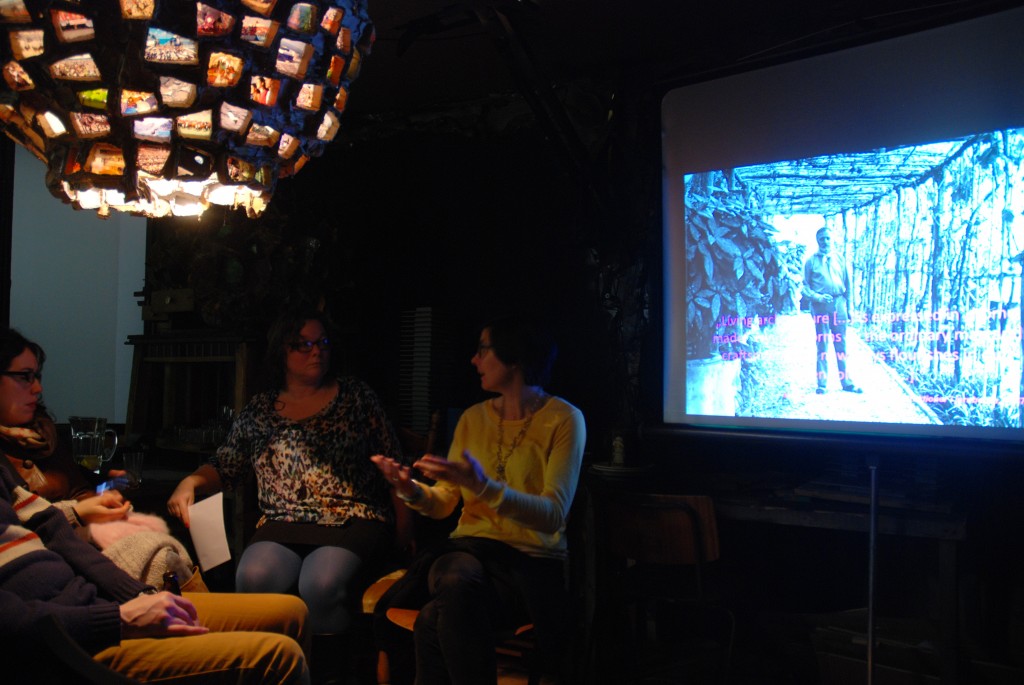
Ruth Baumeister giving a talk inside Rob Voerman’s installation ‘The Fifth Season’, Upstream Gallery Amsterdam, 2014.
L’ architecture sauvage was a talk and interview with Silkeborg-based researcher, critic and teacher Ruth Baumeister at Upstream Gallery, Amsterdam. This session took place Saturday 22 February 2014.
Rob Voerman’s architectural installation ‘The Fifth Season’ conceptually and physically framed the event. As an artist, for the past few years Rob has been creating large-scale installations that are accessible to visitors. The Fifth Season has an additional layer or function, which is to bring people together for meetings, talks, and dinners revolving around the central question of how art and engagement can co-exist. One source of inspiration for Rob´s installation were the ideals of the Bauhaus School. Architect Mies van der Rohe worked within Bauhaus (last director 1930-1933) before moving to the United States in 1937. Here, he designed various iconic buildings that art historically speaking are considered the basis for modern day skyscrapers. Despite the fact that Bauhaus was known for its ideological and socialist character, the buildings Van der Rohe designed were mostly expensive hotels for the upper class. ´The Fifth Season´ is particularly inspired by Van der Rohe’s Seagram building in New York dating from 1958. The Seagram Building is one of the best known buildings by Van der Rohe and right from the start it housed the elitist Four Seasons restaurant. In the 1950s artist Mark Rothko was commissioned to create a series of paintings for the restaurant. The story goes that that Rothko accepted the commission but without telling anyone decided to create “something that will ruin the appetite of every son-of-a-bitch who ever eats in that room.” (Wikipedia) By the time the works were installed however, Rothko decided that the works would “be nothing more than a decorative element in a space where the rich enjoyed their overpriced dinners”, and took the paintings back.
In respect to Asger Jorn, the vocabulary that Voerman has been using to talk about the ‘Fifth Season’ bears some striking resemblances. Voerman speaks about his installation in terms of “a living installation” in which people can sleep, eat, work and meet – Jorn spoke of “a living art”. Voerman speaks of “the complexity of the interconnectedness of systems” in relation to the fact that worldwide problems are so big and complex that we seem to be passed the possibility to change things, as also scientist, environmentalist and futurist James Lovelock claims, whereas Jorn throughout his life worked on the development of no less then “a complete revision of the existing philosophical system” from the perspective of an artist, building on ideas from different fields ranging from physics, mathematics, economics, anthropology, history etc.
In short: a very suitable setting for Baumeister’s talk, which she had structured around four citations from Asger Jorn:
“Functionalism is a construct designed by those without desires – that is, for dead people.” (‘Menneskeboliger eller tankekonstruktioner i jernbeton’, in: Arkitekten, Ugehæfte, Copenhagen, Vol. 49, No. 16/17, 1947)
“Bauhaus is an artistic inspiration, not a doctrine…” (From a letter from Jorn to Max Bill)
“The house must not be a machine to live in, but a machine to shock and capture. A machine of human and universal expression. This is new architecture.” (Letter of Asger Jorn to Enrico Baj, 1953)
“Living architecture […] is expressed in “home-made” housing forms by the ordinary man and craftsman which nowadays flourishes in our garden colonies. […]” (‘Menneskeboliger eller tankekonstruktioner i jernbeton’, in: Arkitekten, Ugehæfte, Copenhagen, Vol. 49, No. 16/17, 1947)
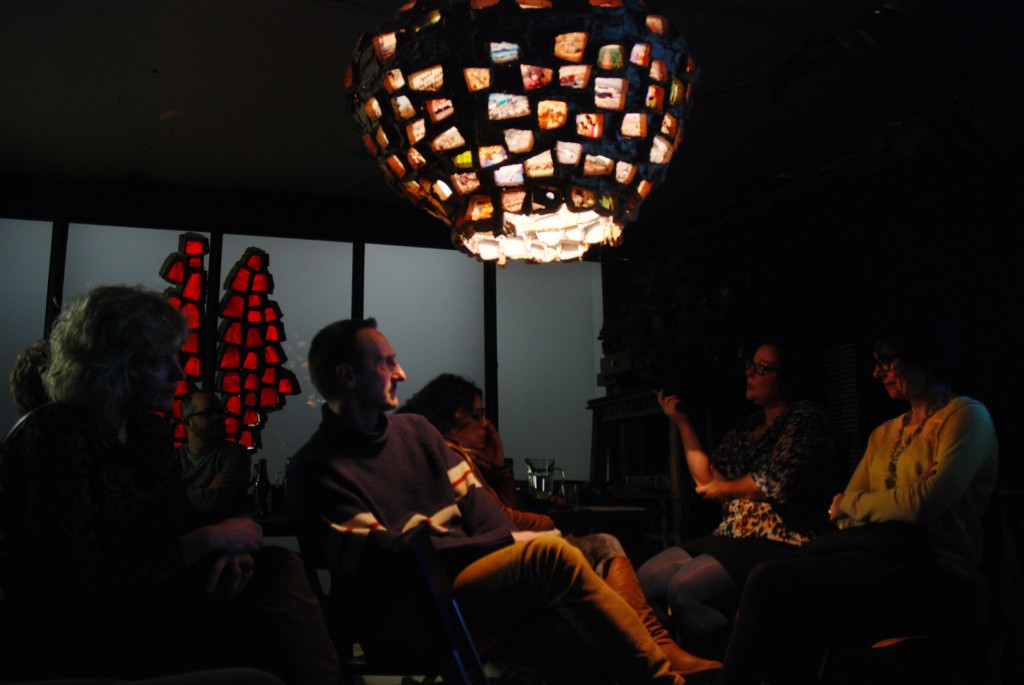
Q&A with Ruth Baumeister inside Rob Voerman’s installation ‘The Fifth Season’, Upstream Gallery Amsterdam, 2014.
Baumeister’s talk was followed by an interview:
HdB: While working on the interview with you on my blog we found out that there are more issues that we would like to address. The session here at Upstream Gallery is a good moment to ask you more about Jorn’s relationship to technology, especially within the discourse of primitivism in architecture. I do know that Jorn has always been interested in science, but I can’t remember reading anything specific about technology as such, or how this would relate to the discourse of primitivism. Could you first say something more about that?
RB: Asger Jorn certainly did not elaborate on technology in architecture as much as he did on the relationship between science and art in his theories, but he does take a clear position. In Pour la forme he states that he is not against functionalism as long as it is for the benefit of people. But if it becomes an end in itself and thus dictates the life of people, then it becomes a problem.
I would argue that he takes the same position when it comes to technology. And even though he criticizes the heroisation of technology by the early century avant-garde, e.g. the futurists, Le Corbusier, Gropius, etc., it does not mean that he is critical of technology in principal. That is also what distinguishes his reception of primitivism from the one by the arts& crafts movement, for example. While Morris and Ruskin reject what technological progress and industrialization has brought about and propagate instead a return to a pre-industrial production and society, Jorn in general accepts developments of industrialization and technology and looks into the future.
If you look at his artistic work, the mural for the Statsgymnasium in Aarhus is a good example for this. You could argue, that he took on the methodological approach of prefabricated industrial production and applied it to a very archaic, if you want “primitive” crafts as ceramics. He created this relief of enormous dimension, by dividing it into over a 1000 singular pieces that he formed, burnt, colored and burnt again in a workshop in Italy and then loaded the whole thing onto a train, shipped it to Aarhus, where it was eventually mounted on site. For the craft production of ceramics, that was very unconventional and certainly technologically advanced.
Thus, the way Jorn created this art piece comes down to his effort to renew an atavistic artistic technique by introducing a new methodological approach. Similar developments you can see in the contemporary digital crafting of ceramic tiles for example.
HdB: One of the other, related issues that we wanted to touch upon is regarding Jorn’s belief that architecture should not be the materialization of a preconceived plan. I think that in relation to this, you wanted to bring up contemporary digital technology as a way to open up new prospects for creating a new architecture, an architecture that can adapt to change (as was one of Jorn’s major demands). Could you tell us more about these developments, and perhaps give some examples?
RB: In his criticism of functionalist architecture, Jorn hit the point of what architects and planners struggle with today, especially when it comes to urban planning. Most often, before a plan materializes, it is outdated and that questions the discipline of planning as such. In his theories, Jorn makes a plea for a living architecture, which he defines as an architecture that is capable of adapting to the ever changing needs of its users. Architecture, as it has been practiced traditionally as well as by the avant-garde of Jorn´s time, works with preconceived ideals, that have a very limited flexibility and are therefore in general not capable to adapt to the ever changing needs of people.
Roberto Matta, for example, whom Jorn met in the late 1930ies in Paris, was originally educated as an architect, worked for Le Corbusier, but finally resigned from architecture and devoted himself entirely to the arts. The reason for this was that he could not identify with any architectural approach and claims, for a living architecture, for spaces, that should be adaptable to human beings. The problem both, Jorn and Matta bring up here is that life is a changing entity while architecture is static. Both Jorn and Matta write in their theories about how to introduce the aspect of time and process.
What would open up new perspectives nowadays for them are the recent developments in parameter planning for example, where the parameters that constitute the planning process can be modified throughout the process. When it comes to your question of primitivism, contemporary development of participatory planning are also interesting, where a good share of what was formerly the work of the architect, especially for the housing sector, is now taken over by other participants, e.g. users, laymen, etc.
HdB: Jorn’s ‘primitivism’ is very much in line with the idea that any human action, institution or custom is at its purest at the moment of inception, and this idea very much informed his thinking about architecture, and its role in society. How do you feel that this stands in relation to Jorn as a highly ethically and politically motivated artist, a position that seems to precede and pervade anything he did as an artist? Would you agree with me, that the rhetoric of ‘spontaneity’ connected to his practice sometimes seems to be at odds with that? Or should I rethink my idea of what spontaneity is when it comes to Jorn?
RB: First of all, I would avoid talking about purism when it comes to Jorn´s ideas in general. What he does is criticizing Western (architectural) culture and in this respect he argues, that every child could do better, because he or she had not been “spoiled” by this what he conceives as indoctrination. I do not see this to be a contradiction to the fact that he is a highly ethically and politically motivated artist, the contrary. In addition to that, I do not see why as an artist you could not be ethically and politically motivated and work spontaneously at the same time? Apart from that, I think his practice is highly complex and differentiated. Depending on which art work you would choose, spontaneity would play a different role. Luckily, especially once he was internationally recognized and sold well, he was frantic about repeating himself and therefore searched for new means of artistic expressions all of his life. This is what makes him so interesting for me as an artist, but, of course, difficult, if you want to pin point him on one specific approach or methodology he uses.
HdB: Jorn was brought up in a very religious family, but stepped out of the religious community at a rather young age to engage with Marxist politics and philosophical questions concerned with explaining the fundamental nature of being and the world that encompasses it, as well as theories from a range of other disciplines. This led him to take on a ‘materialist’ stance, a view on the world that doesn’t seem entirely devoid of spiritual/religious aspects. I’m not sure what terminology to use … Think for instance of the way that he talks about ornamention as the ‘geometry of life’, and as ‘the grammar of substance’, how all matter including human beings are part of one and the same and how the movement of each affects the movements of other(s), or other matter. Would you feel inclined to relate his religious upbringing to his later attitude towards life?
RB: To me, the answer to this is very obvious and therefore rather short. He did refuse his religious upbringing, because of all the restraints that came with it. He did not resent spiritualism, the contrary. If you look at his oeuvre, a lot of his work is very spiritual and the fact that he declared himself to be an atheist, does not mean that religion would not play an important role for him anymore. Especially if you look at the titles of his art works for example, many of them are quotes or recall scenes from the bible. When it comes to the vacuum, that a rejection of God leaves, the “Sinnfrage” it unevitably poses, I think he simply substituted religion with art and he was certainly not the only modernist artist who did so. Just think of Wassily Kandinsky´s book “Über das Geistige in der Kunst”, München, 1912, which was published in many editions and read by a whole generation of artists.
HdB: You also indicated that you would like to refer to Le Corbusier’s famous statement that the house should be a machine for living, in contrast to Jorn’s idea of a house as a machine for expression which is connected to his critique of the modernist paradigm of “Form follows function”. The word ‘expression’ has very strong connotations that have to do with the personal, with authorship …. I know that Jorn had strong opinions about that. I think that I read somewhere that he for instance insisted on the idea that a painter has to sign his paintings. Not as a mark of his genius, but to be transparent about its process of making. How do you perceive Jorn’s use of the term ‘expression’ in relation to notions of authorship?
RB: I never got across the quote that you refer to, but I think it is not so much the authorship as such, that he wants to emphasize, but the subjectivity that lies in art and architecture as a human expression. This is what he wanted to see emphazise and nurtured and a lot of modernist artists and architects strived to eliminate at the same time. In terms of architecture, Jorn pointed at the façade of a building as a surface for expression and a means of communication. It is important to remember here, that he realized the power of architecture in this respect when he worked for Le Corbusier at the 1937 world exhibition in Paris, Le Corbusier´s Pavillon de Temps Nouveaux was explicitly instrumentalized to communicate the political agenda of the Popular Front on the one hand and Le Corbusier’s and Ciam’s agenda for architecture and urbanism on the other. This experience cannot be estimated enough when it comes to Jorn’s understanding and being an artist. As a very young age, he discovered left winged politics for himself and that coincided more or less with his discovery of the arts. For the first time in Paris, at the world exhibition he sees both, politics and arts coming together. Throughout his whole life, Jorn had an agenda – politically, artistically and also personally – and art was a means or maybe even a necessity for him to express it.
HdB: Jorn tried to change the relation between science and art by diminishing the dominant functionalism of science. As you have pointed out also elsewhere on my blog, this has certainly a high relevance for us living in what Guy Debord (1967) called the “Society of the Spectacle”, in which authentic social life has been replaced with its mere representation. In terms of architecture the representation of a building in mass media has become more important than the building itself. You mention however many more issues that Jorn raises which are also connected with the discussion in architecture theory today: identity in architecture and urbanism, architecture as an instrument of social policy, parameter design, to name a few. Could you say more about these connections?
RB: As I have explained earlier, he learned about the power of architecture as a means of expression at the World Exhibition in Paris in 1937. Upon his return to Denmark after this stay, he engages into the debate for a tower for the Arne Jacobsen´s design for the Aarhus City Hall for example. Jacobsen won the competition for the design of a new City Hall, which raised a debate among general public and politicians, who claimed, that this building could be anything, an office building, school, etc. Instead, they claimed a building that they could identified with and demanded a tower, as a sign that is visible in the skyline of the city. Jorn and his friend, the Danish architect Robert Dahlman Olsen, whom he had met during his stay in Paris, took side of the people and in a couple of articles explained the capacity and necessity of a tower as a means to transmit identity.
Regarding the issue of architecture as a means of social policy, I think Jorn, as much as modern architects themselves totally overestimated themselves in this respect. A piece of architecture or urban fabric is a very complex entity and there are many factors, e.g. climate, investment parameters, building law, ect. that determine what it is, not only the idea and/or the will of a single architect.
HdB: Now you have finished your doctoral thesis, I would be curious to know if so far your findings have been consistent with your previous findings on Jorn, or whether you have across anything truly surprising?
RB: Unfortunately, I have to correct you here. I have not finished my doctoral thesis now, but I already finished it in 2009. That means that it took me another 5 years to revise and publish it in English, meaning that I continuously encountered new surprising findings. I came to realize though, that I simply had to stop, because there is no end to a study on Jorn, unless you set it yourself. Right after Architecture Sauvage, Asger Jorn´s Critique and Concept of Architecture went into print by the end of last year, I started another book on Jorn, Asger Jorn, in image, words and forms. It is a general, image based introduction to his oeuvre in English, Danish and German, which will come out at the end of this month and I feel that this is enough now. Time to burry my hero! Who would care about what a 100 year old fellow has to say these days anyhow…?!
